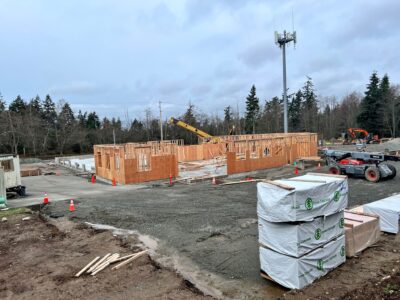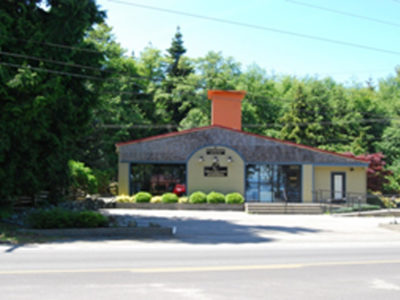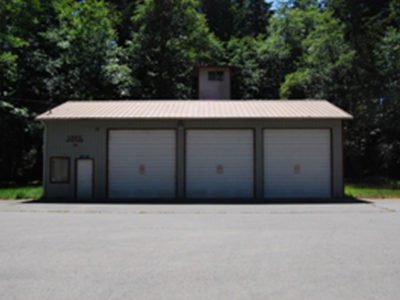History
1928
Formation of the Coupeville Volunteer Fire Department to provide fire protection for the Town of Coupeville and the surrounding area. The department’s fire apparatus consisted of a simple hose cart stored near the library on Front Street. Over the next several years, the department moved to an old barn on Main street and then to a shed on the corner of Northeast First and Second Streets.
1930
The fire department’s hose cart was replaced by a new hose cart that could be pulled by a car or truck.
1931
The Coupeville Volunteer Fire Department arranged to have fire prevention messages published in the local newspaper. This was the first documented effort to proactively reduce the risk of fire in the Central Whidbey community.
1934
The Coupeville Volunteer Fire Department purchased a 1926 Packard chassis and converted it to a fire engine. There is little detail on this apparatus, but department records indicate that it carried 2-1/2” and 1-1/2” hose.
1936
The department purchased a second Packard for use as a fire engine in the Town (the original Packard equipped with the pump and water tank was designated for responses outside the hydrated areas of Coupeville).
1948
The department purchased a Howard Cooper fire engine on a GMC Chassis which was equipped with a 500 gpm pump. This was the Coupeville Volunteer Fire Department’s first purpose-built fire apparatus. After the purchase of this apparatus, the front mount pump was removed from the original Packard.
1952
Formation of Island County Fire District 5 to fund fire protection in the area surrounding the Town of Coupeville and south to the unincorporated community of Greenbank. The fire district and the Coupeville Volunteer Fire Department shared the same station at 904 NW Alexander Street.
The fire district constructed a single-story, two-bay station at 25271 State Route 525 to serve the unincorporated community of Greenbank.
Upon the formation of Island County Fire District 5, the Board of Fire Commissioners needed fire apparatus and reached an agreement to purchase the (original) 1926 Packard from the Coupeville Volunteer Fire Department for one dollar. Not yet having tax revenue, the district received a donation from the Coupeville Lions Club in the amount of $1,000 to purchase and equip the Packard. The district purchased a high-pressure pump, 200-gallon tank, several hundred feet of 7/8” hose to place the apparatus in service as the district’s first fire engine. In the same year, the district purchased a 750 gpm triple combination pumper from the Howard Cooper Corporation.
1985
1987
The Town of Coupeville entered into an interlocal agreement with Island County Fire District 5 to provide fire protection for the town. The district purchased a 2500-gallon water tender to provide water supply in rural areas without fire hydrants. Based on the assessment of the risk presented by the many steep slopes and bluffs along the shores of Whidbey Island, the district implemented a rope rescue program.
1988
Central Whidbey Island Fire & Rescue hired its first full-time fire chief.
1990
The initial effort to annex the Town of Coupeville into the fire district failed by 21 votes in the Town of Coupeville while passing overwhelmingly in the unincorporated areas of the district.
1991
The district purchased a 2000-gallon water tender to improve rural water supply capability.
1992
The district consolidated the Ledgewood and Admirals Cove fire stations into a newly constructed Station 53 at 1164 Race Road.
1994
The district purchased a General fire engine with a 1500 gallon per minute pump and 1000-gallon water tank and hired a full-time captain assigned responsibility for maintenance.
1995
The board of fire commissioners changed the name of the district to Central Whidbey Island Fire & Rescue (Island County Fire District #5 remains the district’s official name). The district purchased an additional 2000-gallon water tender, further improving the rural water supply.
1997
Voters in the Town and fire district voted to annex the Town of Coupeville into the fire district. In addition, the Town of Coupeville entered into an Interlocal Agreement with CWIFR to perform fire inspection of the following classifications of occupancies: Assembly, Business, Education, Factories, Hazardous, Institutional, Mercantile, Transient Residential, Long Term Residential, Day Care, Storage, Licensed Care, Child Day Care, Adult Family Homes, and Home Industries.
1998
The district continued fire station consolidation, combining the Lagoon Point and Greenbank fire stations into the current Station 54 at 3253 Day Road in Greenbank. In addition, the district hired a second full-time captain with responsibility for training.
1999
Station 53 was expanded with the addition of three drive-through apparatus bays and a single wide manufactured home placed behind the station to provide crew quarters for on-duty staff.
2000
The district hired two full-time firefighters, who along with the two full-time captains worked a four on, four off rotation of 12-hour day shifts to provide increased staffing during the day when fewer volunteers were available for response.
2003
The district began delivering monthly cardiopulmonary resuscitation classes to the community and upgraded its marine rescue capability with the purchase of a 17-foot rigid hull inflatable boat (RIB) with a 70-horsepower outboard engine.
2004
Central Whidbey Island Fire & Rescue partnered with the Whidbey Island Public Hospital District to construct the current Station 51, a combined fire station and emergency medical services office located at 109 N Main Street.
Based on staffing and training challenges, the district discontinued its rope rescue program and implemented technical rescue mutual aid from Naval Region Northwest Fire and Emergency Services at Naval Air Station Whidbey Island.
2005
The district hired two additional full-time firefighters and the training captain was moved from rotating shifts to a Monday through Friday five-day week. This provided a (day) shift strength of two Firefighters and a Captain working Monday through Friday.
2007
The district refurbished its 1991 and 1995 water tenders by moving the tanks and pumps to a 2007 Freightliner Chassis.
In addition, the district hired two additional Full-Time Firefighters bringing the total number of Full-Time Firefighters to six and changed the firefighters’ work schedule from 12-hour day shifts to 24-hour shifts on a 24/48 work schedule. This provided assigned staffing of two Firefighters per shift.
2008
Shift staffing was increased in 2008 through an interlocal agreement with the Whidbey Island Hospital District which provided partial funding for 2 full-time equivalents (FTE) positions to staff a BLS ambulance for the hospital. These positions were filled with a mix of firefighter/emergency medical technicians (EMTs) and single role EMTs. CWIFR also established the position of full-time Battalion Chief assigned responsibility for the functions of training and operations. Shift personnel was supervised by a Firefighter acting-in-capacity as a Lieutenant.
2009
Part-time staffing was shifted to strictly firefighter/EMTs and implemented a policy change to maintain at least one full-time member on-duty at all times providing a shift strength of between two and four (depending on leave).
2010
The district began the process of adjusting the size and composition of its fleet to meet the current and future needs of the community. The number and composition of staff and support vehicles was reduced, and the number of fire engines was reduced from five to four. Consolidation of Stations 51 and 52 in 2011 provided a Type I Engine, Water Tender, and light apparatus (Type 6 Engine or Light Rescue/Air Unit) at each of the district’s three stations. The district’s reserve Type I Engine was stored at Station 51.
Several district personnel attended the resuscitation academy at Harborview Medical Center in Seattle and returned to implement high-performance cardiopulmonary resuscitation (CPR) and cardiac arrest management within the district and across Whidbey Island. The district also began a program to deliver hands-only CPR on an anytime anywhere basis for district residents and businesses. In addition, the district began support of a public access defibrillation program to increase access to automatic external defibrillators (AEDs) throughout the community.
2011
Station 52 on Morris Road was decommissioned as a fire station and apparatus was relocated to Station 51 in Coupeville. This facility was converted to the district’s logistics facility and used for storage. The District’s 2500-gallon water tender developed a severe leak in the water tank and was refurbished, replacing the tank and installing a 750 gallon per minute rated fire pump. This water tender was designated as Tender 51 and assigned to the fire station on N Main Street in Coupeville. The district began the process of equipping each type one (structural) fire engine with 1100 feet of 5” hose to improve water supply capability in both hydranted and unhydranted areas.
The district was successful in passing a levy lid lift to fund ongoing operations and additional positions; a captain assigned responsibility for recruitment and training, a firefighter/mechanic, and a part-time office assistant.
Central Whidbey Island Fire & Rescue’s mission was redefined to “partner with the community to reduce risk…”.
2012
Central Whidbey Island Fire & Rescue conducted an officer development program and subsequently promoted three full-time Lieutenants to provide consistent shift supervision. One of these lieutenants was assigned as the acting in capacity training and recruitment captain.
2014
The district refurbished its two 2000-gallon water tenders, replacing the tanks with 2500-gallon tanks and 750 gallon per minute pumps similar to Tender 51 and purchased a new type one (structural) engine.
In addition, CWIFR entered into an agreement with Island County to conduct annual Fire and Life Safety Inspections for all commercial buildings within the unincorporated areas of the district.
2016
Funding for the district’s full-time shift personnel was transferred from the Operations Division to the Community Risk Reduction Division. This budgetary and accounting change reflected the major role of the district’s full-time staff in community risk reduction. In addition, the district improved its all-weather marine rescue capability with the purchase of a 25-foot aluminum hull safe boat with two 225 horsepower outboard engines.
2017
The district’s voters approved a bond measure to fund renovation and expansion of Station 53 to include an apparatus maintenance bay, crew quarters in the station, and expanded office space along with the purchase of three type one (structural) fire engines.
The district re-implemented its technical rescue program with a focus on rope rescue skills and entered an automatic aid agreement with South Whidbey Fire/EMS for a joint response to technical rescue incidents in both districts.
2019
Based on analysis of staffing patterns and an increase in revenue related to the district’s interlocal agreement with the Whidbey Island Hospital District to staff basic life support (BLS) ambulance, the district decreased part-time staffing from 4.5 to 3.0 full-time equivalents and hired two additional full-time firefighters to increase shift staffing reliability.
2020
The district replaced its two small 2006 multi-purpose apparatus with type five (wildland) engines and trained members to certify as wildland type two firefighters. This apparatus purchase and training program dramatically improved the district’s wildland firefighting capability.
The district entered into agreements with the Washington State Patrol for all-hazards mobilization, with the Washington Military Department (Emergency Management) for interstate all hazards mobilization, and with the Washington Department of Natural Resources to provide contract wildland firefighting support outside the district’s boundaries.
2021
Central Whidbey Island Fire & Rescue purchases three new type one engines with proceeds from a voter approved bond.
2022
Construction begins on a new fire station to replace the current station 53 on Race Road.

2023May 2023
Jerry Helm hired as new Fire Chief to replace the retiring Chief Ed Hartin



















